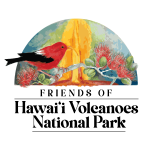Some Kīlauea summit areas will reopen on Monday, June 15, 2020
Hawaiʻi Volcanoes National Park News Release: June 12, 2020
Contact: Jessica Ferracane, Public Affairs Specialist
jessica_ferracane@nps.gov, 808-985-6018
Hawaii National Park, HAWAI‘I – Following guidance from the White House, Centers for Disease Control and Prevention (CDC), and state and local public health authorities, Hawai‘i Volcanoes National Park continues to increase community access to park roads, trails and scenic overlooks in phases. On Monday, June 15, the collection of entrance fees will resume, and these areas will reopen for outdoor enjoyment and exercise by 9 a.m.:
- Crater Rim Drive to Kilauea Military Camp, and to Devastation Trail parking lot
- Kīlauea summit area trails, including Byron Ledge Trail (newly repaired following the 2018 eruption and summit collapse), Devastation, and Halema‘uma‘u trails
- Kīlauea Iki Overlook and trail (one-way counterclockwise loop only)
- Chain of Craters Road to Mauna Ulu parking lot
- Pu‘uhuluhulu and trails near Mauna Ulu, including Nāpau and Nāulu trails (day use only)
- Ka‘ū Desert and Mauna Iki trails (day use only)
Businesses in the park that meet local and federal public health requirements will also reopen with limited services, including Volcano House, Kilauea Military Camp, Volcano Art Center Gallery and the park’s non-profit partner, Hawai‘i Pacific Parks Association. Contact the businesses directly for dates and details.
Areas already open:
Mauna Loa Road to Kīpukapuaulu for vehicles, bicyclists and hikers, including Tree Molds and Kīpukapuaulu Trail. (The pavilion, picnic area and restroom remain closed).
- Mauna Loa Road past Kīpukapuaulu is open for hikers and bicyclists to Mauna Loa Overlook at 6,662 feet, but is closed to vehicles for wildfire prevention.
- Footprints Trail from Highway 11 to the Ka‘ū Desert Trail and Mauna Iki Trail junction, including the Footprints shelter.
- Escape Road, for bicycling, horseback riding and hiking.
All other areas in the park remain closed at this time for public safety, including Nāhuku and Kīlauea Visitor Center.
“Services are limited, and visitors should bring everything they might need for a safe visit including water, meals, and hand sanitizer. Above all, visitors should pack their patience, avoid crowds, and have alternate destinations planned should parking lots be full,” said Hawai‘i Volcanoes National Park Acting Superintendent Rhonda Loh.
Visitors are urged to recreate responsibly by planning their visit in advance and acting with care while in Hawai‘i Volcanoes National Park:
- Practice social distancing. Maintain at least six feet of distance between you and others.
- Wear a face covering when social distancing cannot be maintained.
- Wash your hands often with soap and water for at least 20 seconds or use your hand sanitizer.
- Cover your mouth and nose when you cough or sneeze.
- Avoid touching your eyes, nose, and mouth.
- If you feel sick, please visit another day.
- Let wildlife be wild. Do not feed nēnē, the Hawaiian goose, and look out for them on roadways and in parking lots.
The health and safety of park users, employees, volunteers, and partners continue to be paramount. While these areas are accessible for the public to enjoy, a return to full operations will continue to be phased and services are limited. Park users should follow local area health orders from the Governor of Hawai‘i, practice Leave No Trace principles, avoid crowding and other high-risk outdoor activities.
The CDC has offered guidance to help people recreating in parks and open spaces prevent the spread of infectious diseases. Park staff will continue to monitor all park functions to ensure that visitors adhere to CDC guidance for mitigating risks associated with the transmission of COVID-19, and will take any additional steps necessary to protect everyone’s health.
Details and updates on park operations will continue to be posted on our website www.nps.gov/hawaiivolcanoes and social media channels. Updates about NPS operations will be posted on www.nps.gov/coronavirus.
